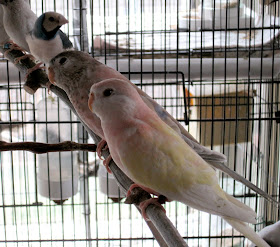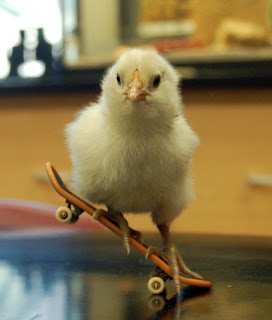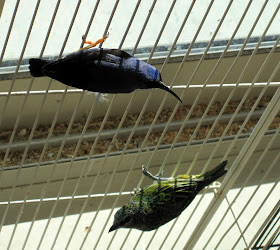I'm so impressed with these photos that was sent to me through one of those chain emails that I just had to share it. I can't give credit to the photographers since that was not included, so if any of these is taken by you, feel free to let me know and I'll post credit where credit is due.
A place to share experiences in keeping and breeding birds, specifically different finches and grasskeets.
Monday, November 21, 2011
Monday, November 14, 2011
More softbills...
Wednesday, October 26, 2011
New baby and bird pictures
 |
| red legged honeycreeper pair |
 |
| red legged honeycreeper male |
 |
| spotted tanager |
 |
| scarlet chested parakeet baby |
 |
| gray white fronted blue male scarlet chested parakeet |
 |
| lutino and pale fallow bourkes |
 |
| baby normal gouldian finch |
 |
| pastel and yellow baby gouldian finches |
 |
| red brown society finch babies |
 |
| star finches and cordon blue male |
 |
| male strawberry finch |
 |
| yellow faced star hen and male forbes parrot finch |
 |
| male forbes parrot finch |
 |
| melanistic red headed purple breasted normal male and red headed white breasted normal backed hen gouldian finches |
 |
| gouldian babies from the above pair |
 |
| orange headed yellow gouldian pair |
 |
| black headed silver male and black headed yellow male gouldians - babies from last year |
 |
| black and white mannikin |
 |
| heavily pied red faced parrot finch |
 |
| dominant pied blue canary male |
Thursday, October 20, 2011
New babies of the season
I'm a little behind on pictures, but do have some new babies coming out of the nest. A few gouldian pairs finally got in the mood and are raising broods. The seagreen parrot finches have 3 new babies that needs close banding soon. The scarlet chests have a few new babies in the nest as well. The bourkes and turquosines have decided to molt instead. Hopefully the forbes pair and purple grenadiers will have some fertile eggs soon. The shaft tails seem enthusiastic, but eggs are not fertile. Societies are raising babies too, but with some sporadic results so far.
Unfortunately, when the seasons change, there is a higher chance for birds to get sick and die. I do have some tenants in the hospital cage and have lost a few birds sadly. The higher mutations due tend to be more susceptible despite all the precautions.
Friday, September 16, 2011
Treating illness.
Since I'm having some slow down in the aviary activity (pairs of gouldians, stars, owls, societies, keets have been set up but most don't seem that interested yet), I decided to take this opportunity to post some of my experiences for treating illnesses in birds. Majority of sick birds in my aviary are gouldians. They just seem to get sick more easily than other birds. Otherwise, higher mutations of any bird species do tend to have health problems more easily than their non-mutant normal counterparts.
The first problem with treating illness is to figure out if a bird is sick. As part of their survival instinct, birds like many animals will try to hide signs of illness to avoid predation. This means the vast majority of the time, when a bird is showing obvious signs of illness, the infection (most common problem) may be fairly advanced already. Constant monitoring of poop, as unpleasant as it may seem, can be very helpful to detect illness earlier on. Normal droppings are fairly dry and solid mostly consistent of half chalky white urate and half dark green/brown (depending on diet) fecal matter. I've noticed my grasskeets tend to have greener colored droppings and the shaft tails tend to have a reddish/orange tinge. If droppings are extra wet, off colored, bad smelling, or have seeds in them, sure signs of illness.
A fluffy bird may be a cold bird, but if it stays fluffy, it's a bad sign. A bird that is constantly sleeping is not healthy either. While we can not catch each bird all the time to check, but catching a bird that is not looking 100% is important because one needs to make sure the bird has not lost a lot of weight - this can be easily done by feeling the breast area - if the keel bone feels sharp the bird is too thin.
Treatment of birds illnesses depends on the cause of the infection obviously. If one has a good avian vet, then one is very lucky. Sometimes they can at least do fecal smears. Most of the times, I've found I have to be my bird's vet - majority of the cases will be bacterial, but under the right conditions, protozoal/fungal infections may be the cause as well. In general, however, I've found that giving anti-bacterial antibiotics require higher dosing than what is on the label. Perhaps due to the birds not drinking as much water when they are sick or perhaps due to higher metablism of the birds; I've not had much luck curing any infections in my birds until I started to make medicated water 2 times as concentrated as what's on the bottle.
If a bird is lethargic, not eating/drinking much, and/or is very thin, crop feeding is usually needed to keep it alive - I crop feed medicated water as well as baby bird formula at least twice a day. This, in addition to heat lamp in a hospital cage with lots of eggfood and millet can give a sick bird a better chance at recovery. This is especially important for smaller birds - the smaller the bird (finch) the less reserve it has, and the more likely it'll die if measures are not taken quickly.
Hope everyone's birds stay healthy and happy!
Saturday, September 3, 2011
New scarlet babies and bobcats
All girls from my normal and lutino scarlet pair. They should all be normals, but interestingly the babies from this pair has an overall paler appearance than my other normal babies - very pretty.
Saw a nice family of bobcats in my front yard - made my day!
Saw a nice family of bobcats in my front yard - made my day!
 |
| the kittens |
 |
| mom and 4 kittens |
 |
| newly fledged scarlet baby hen |
 |
| dad and baby scarlet |
Thursday, August 18, 2011
High hopes for new breeders...
 |
| opaline turquoisine hen and creamino (par blue ino) scarlet hen |
 |
| red fronted yellow opaline male turquoisine |
 |
| aqua male turquoisine (may be single factor violet) |
 |
| rosey bourkes |
 |
| white face pink bourkes |
 |
| pink and rosey bourkes |
 |
| red front yellow turquoisine male |
 |
| ?opaline red bellied/front yellow turquoisine hen and rosey bourke hen |
 |
| bunch of bourkes |






















